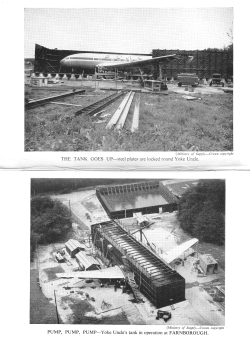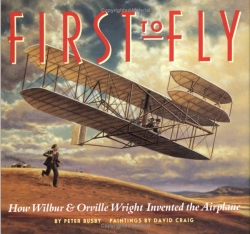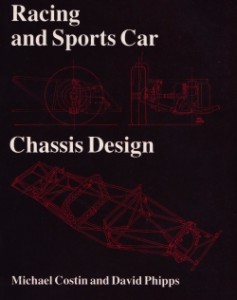More books to read…
Orville and Wilbur Wright were genuine engineering heroes. Despite their relatively humble beginnings, these men were the first to ever to build – and then successfully fly – a powered aircraft.
I’ve often read descriptions of their brilliance that damns them with faint praise: they were ‘just bicycle mechanics’, their work built heavily on the efforts of others, and so on.
In fact, they were simply brilliant engineers, with an astounding work ethic and the ability to both physically make things and also theorise about outcomes.
Unless you think I overstate the brothers’ abilities, consider these points… They built their own wind tunnel and tested in it almost 200 wing sections; they built an internal combustion engine with the then best power/weight ratio of any engine in the world; they made every part of their own aircraft – from that engine through to propellers to wing and control systems; they developed the concept of an aircraft banking into turns – and a lot more.
First to Fly, by Peter Busby, is a large format, 32-page children’s book. However, with superb paintings by David Craig and lots of contemporary photographs, it presents the abilities of the Wright brothers in an accurate and accessible manner. Certainly I’m happy to have it on my bookshelf!
The Wright brothers’ memorial at Kill Devil Hills says of their aircraft: “Conceived by genius. Achieved by dauntless resolution and unconquerable faith.”
And that’s so right.

I bought sight unseen on eBay Lotus Elan by Duncan Wherrett. When the book arrived I was a bit disappointed: it’s just a picture book, when I was hoping for a more detailed technical history.
But the saving grace is that the pictures are very good: there are lots of close-up detailed shots of the bodies, and sufficient pics of engine bays and suspension. The captions are also long and frequently detailed.
However, it still remains the sort of book you can read from cover to cover in a few hours of slow browsing.
The Elan itself – Colin Chapman’s seminal sports car launched just over half a century ago – remains a fascinating car. From its mixture of cutting edge chassis and body design to the way it used relatively pedestrian parts from other cars, it shows what was able to be achieved by innovation and fundamentally good design.
However, this publication has just made me resolve to find a better book on the car!

The Comet Riddle by Timothy Hewat and WA Waterton is an excellent book.
The Comet was the world’s first jet passenger airliner, produced just after World War II by the de Havilland company in the UK. It built upon the invention of the jet engine by Sir Frank Whittle, and the experience de Havillands had with the first jet fighters.
A beautiful looking aircraft, it revolutionised passenger air travel and led the world. But it was also an aircraft with a fatal flaw. After a series of minor – and not so minor – incidents and accidents, Comets started to disintegrate mid-air, killing all those on board.
A massive government scientific investigation was undertaken to find the cause of the failure, with metal fatigue an early suspect. The scientists built an enormous metal water tank in which the aircraft’s fuselage could be placed, the wings protruding from the tank each side. The wings were flexed by hydraulic jacks and the cabin was cyclically pressurised by water, the processes simulating the actions of flying a pressurised aircraft.
After some time, the cabin wall failed. The wings also showed bad fatigue cracks.
Thousands of pieces from one of the crashed aircraft were also recovered from the ocean floor and reconstructed on a life-size framework. This showed that metal fatigue cracks had propagated from a fibreglass inset ‘window’ in the roof of the aircraft.
That much is all well known. But this book, published in 1955, also makes some amazing points that are much less discussed.
As built, some of the Comets came complete with factory cracks! Incredibly, production workers simply drilled a hole at the end of each crack to stop it spreading! (These cracks were apparently not responsible for the crashes, but the mind boggles at the thought of the aircraft being signed-off from the factory with cracks already in it!)
The stressing calculations by de Havillands were way out. Government scientists calculated that in every flight the aluminium cabin skin was stressed to 70 per cent of its ultimate strength!
And there were other design problems as well. For example, the jet effluxes impinged on the fuselage, causing it to weaken over time. The plane was also difficult to lift off, the angle of ascent required to be attained by the pilot hard to ascertain at night or when there was no horizon.
But the book also makes the point very clearly that no technological advance is undertaken without risk: the official enquiry found no individual, company or regulatory agency to blame for the crashes.
An excellent book, very clearly and tightly written.
Racing and Sports Car Chassis Design by Michael Costin and David Phipps was first published in 1961; the edition I have was reprinted in 1991.
The book attracts high secondhand prices and is actively sought by enthusiasts. But, while it is excellent in some parts, it has largely been replaced by better books that have appeared subsequently.
The best part of the book deals with chassis design – ladder frame, multi-tubular, space frames and unitary construction. Here each of the approaches is shown by excellent drawings of contemporary race cars, and the commentary on the different designs is incisive and accurate.
Whether you are building a race car, an ultra lightweight vehicle (eg powered by electricity or human legs) or simply want to improve your knowledge of the fundamentals of vehicle design, this is an excellent section.
But from there the book goes downhill. At a glance it looks great – the line drawings of different suspension types are clear and the descriptions (as far as they go) are fine. But the book supposes a level of knowledge that, if you have it, will mean the text isn’t of great interest – and if you don’t have it, will make the text hard to follow!
For example, if you know the significance of roll centres (how to calculate them, what they mean, the results in terms of body roll and lateral wheel movement) then the book doesn’t tell you much. And if you don’t know what a roll centre is, then you’ll struggle to understand it by reading this book.
The same comments apply to springs, dampers and anti-roll bars. In fact, the latter is a real eye-opener; I hadn’t realised that in the late Fifties and early Sixties anti-roll bars were regarded as so new and special!
I certainly don’t want to suggest it’s a bad book – when first published, it must have been great. For the experienced constructor it also has quite a few points of the ‘food for thought’ type. But I don’t think it’s worth paying the high secondhand prices it often commands.

 Julian Edgar, 50, has been writing about car modification and automotive technology for nearly 25 years. He has owned cars with two, three, four, five, six and eight cylinders; single turbo, twin turbo, supercharged, diesel and hybrid electric drivelines. He lists his transport interests as turbocharging, aerodynamics, suspension design and human-powered vehicles.
Julian Edgar, 50, has been writing about car modification and automotive technology for nearly 25 years. He has owned cars with two, three, four, five, six and eight cylinders; single turbo, twin turbo, supercharged, diesel and hybrid electric drivelines. He lists his transport interests as turbocharging, aerodynamics, suspension design and human-powered vehicles.



on December 9th, 2008 at 7:51 pm
You don’t happen to have a book called ‘How to Build a Sports Car for 250 Pounds’ do you? Rumour is that it’s pretty good manual for building a clubman stye car. I think it deals with converting an escort, but in theory any front engine rear drive can be used.
on December 10th, 2008 at 11:30 am
With regards to the Comet and the practice of drilling a hole at the end of a crack (Stop drilling). This is a valid repair for a lot of metallic structures in aircraft and is in widespread use in an aircraft maintenance environment. However in a design environment, signing off on a stop drilled crack that appeared during production is very much a no-no. It means the design and/or the production process are flawed. Things like edge preparation, corner radii and bend allowances for the temper of the material used are to blame. The stresses achieved in flight for the airframe aren’t all that unusual depending on what the structure is, but when coupled with the previously mentioned stop-drilled cracks it was always going to make the evening news.
I guess that’s how some of todays design rules & regs came into being, through crashes. Flying in a plane is still safer than driving on the roads, even helicopters are safer than driving…
on December 10th, 2008 at 2:49 pm
I wonder if the horrifying (by today’s standards) details are what you would get… if you were building military aircraft under conditions where your actually factories were being bombed, and producing 100 aircraft where 3 have structural failures is actually a better result that producing 80 aircraft with no structural failures, because in the first case you win the battle and aren’t invaded.
The battle of Britain was an extreme case of aircraft manufacture, and it’s only human to expect that the habits formed then wouldn’t have faded by the early 1950s. Same engineers, workmen and management after all.
on December 16th, 2008 at 3:11 pm
As per usual someone has to write a book furthering the myth that the Wrights were the first to fly a plane. Not a by a long shot unfortunately. New Zealands Richard Pearce Flew a plane of his own design with an engine he built himself long before the Wrights and the plane still exists. I would say that because New Zealand was this unknown little country at the bottom of the world,news of Pearces efforts were practically unknown outside his own district. There were others who flew around the same time,but their names escape for the present. Cheers!